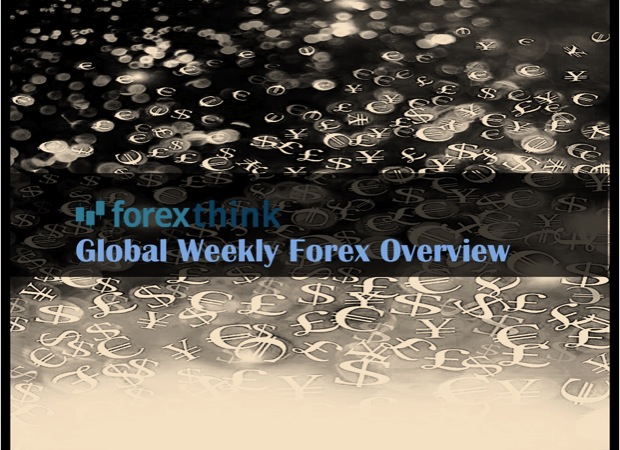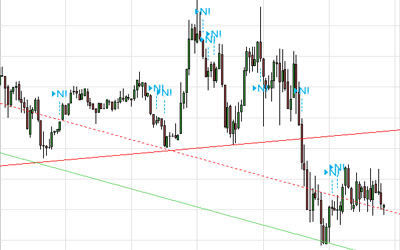
Global Weekly Forex Overview
Fed Chairwoman Yellen’s first press conference was today. She forecast growth no more than 3%, and the Fed will continue to curtail its economic stimulus campaign. Bottom line: Rates will remain at the current level, near zero, “for a considerable time.”
Crisis. What Crisis? Since our last commentary, the world seems to have shaken off worries about Russia and Ukraine. The U.S. dollar has been mixed against the G8 and slightly firmer against the emerging markets. The yen is mildly higher, the Australian dollar is stronger, the New Zealand dollar has outperformed despite a deluge of bad news out of China (More on this later), and the EUR has continued its upper trajectory.
Obama has imposed sanctions and has warned Russia that it will face penalties, if Putin doesn’t back down and get out of Chimea, and the US and EU declared the Crimea referendum for independence from the Ukraine to be illegal. But, so what? Realistically what can, and will, the western powers do? Cut off Russian supplies of oil and gas? That would harm Europe without necessarily changing Putin’s mind. Implied volatilities in almost all G8 pairings are considerably lower showing that Traders’ expectations of future currency swings are at their lowest levels since 2012. So much for Obama’s harsh words rattling confidence in Russia.
Let’s Talk About China
Chinese property developer, Zhejiang Xingrun Real Estate Co, is defaulting on $567 million, which has increased worries that a softening property market is heightening risks for the financial system. Chinese premier Li says that defaults of financial products in China are unavoidable but the government will take steps to ensure they do not pose a threat to the wider financial system. Some hard facts:
- The yuan is down 0.2%, another 11-month low after falling 0.5% on Monday.
- The PBOC said on its website the trade surplus is down to 2.1% of GDP.
- Chinese exports in Feb fell sharply (18.1%) for a $22.9 billion trade deficit, but with imports up only 10.1% the MSCI Emerging Markets index fell only 0.9% and the Shanghai fell 2.86%.
- China reported on Saturday that the official manufacturing PMI fell to 50.2, the lowest since June.
- China announced that it is enlarging the permissible trading dollar/yuan range from 1% to 2%.
In a move that can best be described as reform out of the necessity, China confirmed it will be removing the ceiling on bank deposit rates within two years. China will also permit the formation of 5 new privately owned banks.
Euro (EUR)
It appears that the EUR/USD weakness anticipated may begin later than later than previously thought and may not be as pronounced as previously expected. (How’s that for acknowledging my wrong move?) Despite an overall dovish bias, the European Central Bank continues to hold monetary policy steady for now. ECB inaction, combined with an ongoing gradual economic recovery should support a steady euro in the very near term. Technicals are also favorable.
- Eurozone industrial production fell 0.2% m/m in Jan. A rise of 0.5% was forecast.
- Eurostat revised Eurozone CPI to only 0.3% Feb m/m and 0.7% y/y from 0.8% y/y.
- German ZEW (Who remembers? It’s the Gesellschaft für Konsumforschung, Germany’s largest market research institute) index of German investor and analyst expectations fell from 55.7 in Feb to 46.6 in March against a forecast of 52.
- German retail sales are up 2.5% m/m in Jan and 0.9% y/y, less than forecast,
- French January consumer spending fell 2.1% m/m, four times expectations.
- German industrial production beat forecasts in Jan, up 0.8%, and Dec was revised from -0.6% to +0.1%. Construction was the big item, up 4.4% m/m, due to an exceptionally mild winter.
Interesting note: On March 6th the first big Greek bank sought €3 billion in new equity capital, starting the lengthy process of recapitalizing distressed banks even before the ECB oversight agency completes its reviews.
Current EUR/USD rate is 1.3847
Mid implied volatility is 6.12%.
Current EUR/JPY rate is 141.76
Mid implied volatility is 8.89%.
Recommended Enhanced Yield structure: See Long EUR/JPY structure.
Australian Dollar (AUD)
Sour Chinese economic news and the US Fed policy remain the AUD’s near-term downside risks. That said, Growth and inflation have both firmed, contributing to the RBA “on hold” monetary stance, and the government reported a rise in employment by a stunning 47,300, with full-time jobs up 80,500, the best since 1991. Nevertheless, expect some AUD weakness in the near term, but a continued recovery over the longer term. Implied volatility is off recent highs.
- Q4 GDP firmed to 0.8% q/q and firmed to 2.8% y/y, while final domestic demand edge up just 0.1% q/q.
- January employment unexpectedly fell by 3,700, and the jobless rate rose to 6.0%.
- The forward looking business confidence measure eased to +7.
- January retail sales rose 1.2% m/m, the ninth monthly gain in a row.
- The Q4 wage cost index eased to 2.6% y/y.
- The Q4 current account deficit narrowed to A$10.14B, while the January trade surplus rose to A$1.43B.
Current AUD/USD rate is 0.9053
Mid implied volatility is 8.55%.
Recommended Enhanced Yield structure: Long AUD forward.
- Long AUD/USD forward at 0.9060 for 2-Weeks.
- Sell 2-Week AUD Call / USD Put with 0.9100 Strike (34 Delta).
- Forward’s implicit deposit rate is 2.25%.
- Yield from US dollar cash position 0.24%.
- Yield from option premium 8.61% annualized.
- Structure’s yield is 11.11% annualized (from forward deposit rate, U.S. deposit rate, and option’s premium) plus potential capital gain from AUD appreciation to 0.9100.
Great British Pound (GBP)
The Bank of England has signaled it will likely maintain an accommodative stance for some time, to absorb surplus capacity. While, BoE Gov. Carney said that the MPC has disagreements on capacity and the right unemployment rate. Growth trends are solid and sentiment surveys suggest continued expansion. Due to contained inflation, BOE voted unanimously to hold monetary policy steady. Technicals suggest a consolidation higher, but existing FX longs and trade deficit concerns will limit sterling upside.
- U.K. February claimant count unemployment fell by 34,600, while the January jobless rate was steady at 7.2%.
- Rightmove reported that house prices jumped 6.8% y/y in March, signaling a robust recovery.
- UK reported a Jan trade deficit of £9.8 billion from £7.7 billion in Dec (This is not good). The forecast was £8.6. This is a classic currency long-term devaluation trigger.
- UK factory output rose 0.4% m/m in Jan, the same as Dec, beating the 0.3% forecast.
- Overall industrial production rose 0.1%, under the 0.2% forecast.
Current GBP/USD rate is 1.6521.
Mid implied volatility is 5.94%.
Recommended Enhanced Yield structure: Long GBP Forward
- Long GBP/USD forward at 1.6529 for 3-Weeks.
- Sell 3-Week GBP Call / USD Put with 1.6600 Strike (37 Delta).
- Forward’s implicit deposit rate is 0.28%.
- Yield from US dollar cash position 0.24%.
- Yield from option premium is 6.24% annualized.
- Structure’s yield is 6.76% annualized (from forward deposit rate, U.S. deposit rate, and option’s premium), plus potential capital gain from GBP appreciation to 1.6600.
Canadian Dollar (CAD)
The USD/CAD rallied yesterday after the BoC chief Poloz spoke and said he can’t rule out a rate cut. Borrowing a page from Larry Summers’ handbook he used the phrase “secular stagnation”. Growth remains sluggish as the contribution from business spending and the external sector remains lackluster. Inflation has firmed notably in recent months. Poloz didn’t comment on rumblings from separatist Parti Quebecois Leader, who said a separate Quebec would continue to use the CAD. (Note: the last time Quebec secession was on the front page, the CAD took a hit!) There may be some, but very limited, CAD weakness in the immediate term. FX technicals point to a corrective rebound in the currency. Implied volatility is higher. Enhanced Yield Structures on either side are attractive.
- February employment fell by 7,000, and the jobless rate was steady at 7%.
- The February manufacturing PMI firmed to 57.2
- Existing-home sales fell 3.3% m/m in January, while building permits increased 8.5% m/m.
- The January CPI quickened to 1.5% y/y, while the core CPI quickened to 1.4% y/y.
USD/CAD rate is 1.1261
Mid implied volatility is 7.65%
Recommended Enhanced Yield structure: Long CAD forward
- Short USD/CAD forward at 1.1265 for 2-Weeks.
- Sell 2-Week USD Call / CAD Put with 1.1235 Strike (42 Delta).
- Forward’s implicit deposit rate is 0.00%.
- Yield from US dollar cash position 0.24%.
- Yield from option premium is 15.58% annualized.
- Structure’s yield is 15.82% annualized (from forward deposit rate, U.S. deposit rate, and option’s premium), plus potential capital gain from CAD appreciation to 1.1200
Japanese Yen (JPY)
Expect to see more yen softening. A scheduled sales tax hike in April has the potential to alter the outlook for monetary policy, and may lead to additional Central Bank easing. Between this and US Fed tapering, the yen should continue to weaken. Additionally, JPY technicals are mildly negative.
- Trade deficit was bigger-than-expected in Feb at ¥800 billion. ¥600 billion was forecast. BOJ expressed concern.
- Exports rose 9.8% but imports rose 9% as consumer demand is high ahead of the sales tax hike on April 1.
- The Bank of Japan left rates and QE on hold noting that core inflation is 1.25% and rising.
- Q4 GDP growth slowed to 0.2% q/q and 0.7% y/y.
- The January current account deficit widened to ¥1.59 trillion, over four times the size of the deficit a year ago.
- The December core CPI was steady at 1.3% y/y, while the headline rate eased to 1.4% y/y.
Current USD/JPY rate is 102.42
Mid implied volatility 7.75%.
Current EUR/JPY rate is 141.73
Mid implied volatility is 9.06%.
Recommended Enhanced Yield Structure: Short JPY vs. EUR (As opposed to a JPY vs. USD, because EUR/JPY implied volatility is higher. Additionally, this position offsets the book’s overall EUR exposure).
- Long EUR/JPY forward at 141.76 for 3-Weeks.
- Sell 3-Week EUR Call / JPY Put with 142.40 Strike (44 Delta).
- Forward’s implicit deposit rate is -0.10 %.
- Yield from US dollar cash position 0.24%.
- Yield from option premium is 10.76% annualized.
- Structure’s yield is 11.00% (from forward deposit rate, U.S. deposit rate, and option’s premium), plus potential capital gain from EUR appreciation to 142.40. Additionally, structure benefits from potential appreciation vs. USD.
Mexican Peso (MXN)
Expect a stable Mexican peso over the medium term. Successful implementation of Peña Nieto administration’s policy should help to strengthen growth. Reforms should result in increased economic activity later this year. The Central bank is likely to stay on the sidelines with current growth remaining sluggish. All in all this points to MXN strength, but limited, in the near-term.
- Mexican GDP saw meager growth in 2013, ending the year at a y/y growth rate of just 0.7 percent.
- February consumer prices slowed to 4.2% y/y, and core consumer prices eased to 3% y/y.
- The Bank of Mexico held rates steady at 3.50% in January, while noting an improved economic outlook and transitory inflationary pressures
Current USD/MXN rate is 13.26
Mid implied volatility is 8.94%.
Recommended Enhanced Yield Structure: Sell MXN Put against U.S. deposit, not a forward.
- Sell 2-Weeks USD Call / MXN Put with 13.40 Strike (26 Delta).
- Yield from US dollar deposit 0.24%.
- Yield from option premium is 6.75% annualized.
- Structure’s yield is 6.99 % annualized (from deposit and option’s premium). If option is assigned, result will be long MXN at 13.40.
Guest post by Ronald G. Huddleston Managing Director of Huddleston Capital Management:
Mr. Huddleston has nearly 20 years of financial services experience, with primary expertise in the conceptual and structural development and trading of derivatives. He has also held a range of senior advisory positions working with high net worth and institutional clients, with his most recent role at Wells Fargo focused on the development of customized foreign exchange derivatives for the firm’s ultra high net worth clients. Mr. Huddleston has also held a range of management and trading positions at Capital Markets Trading (Frankfurt), Dresdner Bank (Frankfurt) and Citibank (Frankfurt and Hong Kong). Mr. Huddleston was a member of the Pacific Stock Exchange, where he was an options market maker on Microsoft listed stock options.
Huddleston Capital Management (HCM) is the managing member and investment manager of the Enhanced Yield Currency Fund (EYC). The managing partner is Ron Huddleston, me. HCM is registered in the United States as a Commodity Pool Operator (CPO) and a Commodity Trading Advisor (CTA) with the NFA and CFTC. In addition to the fund, HCM offers managed accounts using OTC options and forwards. HCM is looking to partner with a U.S. bank to introduce foreign exchange managed accounts and investment products that will allow clients to gain alpha, diversify, and hedge currency exposure.
The EYC fund strategy uses OTC options and forwards in a covered call approach; short call options corresponding to the long side of forwards are held. The short calls are covered by the long side of the corresponding forward contract. The option positions match the expiration, notional amount, and the currency of the long side of the forward contract. The positions’ terms range from 2-Weeks to 6-Months.
Tradersdna is a leading digital and social media platform for traders and investors. Tradersdna offers premiere resources for trading and investing education, digital resources for personal finance, market analysis and free trading guides. More about TradersDNA Features: What Does It Take to Become an Aggressive Trader? | Everything You Need to Know About White Label Trading Software | Advantages of Automated Forex Trading











































